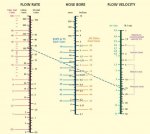Does anyone have a link to a good hydraulic flow rate chart?
Specifically I am looking at what will flow through 1/4, 3/8, 1/2 hose (gpm) at a specific pressure.
Specifically I am looking at what will flow through 1/4, 3/8, 1/2 hose (gpm) at a specific pressure.


